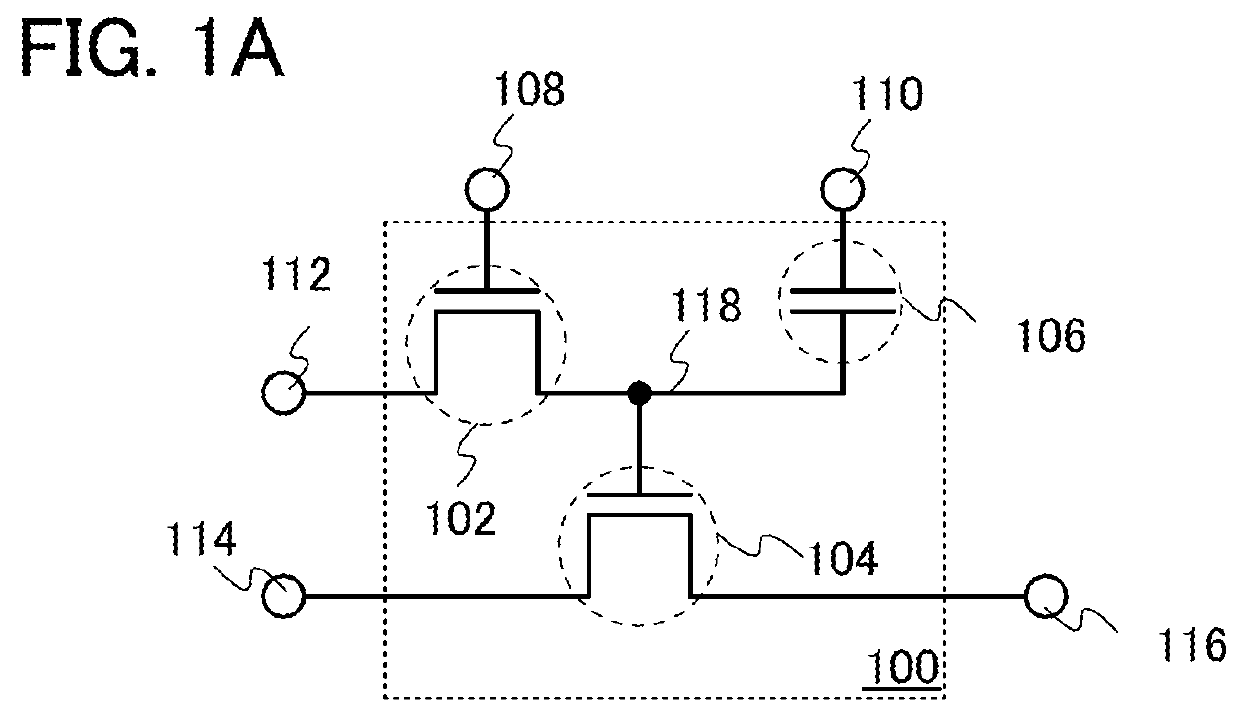Semiconductor device and driving method thereof
a technology of semiconductor devices and drives, applied in the direction of fault response, redundant data error correction, instruments, etc., can solve the problem that the expected value (data based on the remainder) might be changed, and achieve the effect of high accuracy
- Summary
- Abstract
- Description
- Claims
- Application Information
AI Technical Summary
Benefits of technology
Problems solved by technology
Method used
Image
Examples
embodiment 1
(Embodiment 1)
[0029]A configuration of a memory element which can be used for a semiconductor device of one embodiment of the present invention, and the operation thereof will be described.
[0030]Note that the description in this embodiment is made focusing on one memory element; however, in an actual semiconductor device, a plurality of memory elements are arranged in a matrix.
[0031]FIG. 1A illustrates an example of the configuration of the memory element that can be used for the semiconductor device of one embodiment of the present invention. A memory element 100 illustrated in FIG. 1A includes a first transistor 102, a second transistor 104, a capacitor 106, and a data storage portion 118, and is electrically connected to a first terminal 108, a second terminal 110, a third terminal 112, a fourth terminal 114, and a fifth terminal 116.
[0032]One of a source and a drain of the first transistor 102 is electrically connected to the third terminal 112. The other of the source and the d...
embodiment 2
(Embodiment 2)
[0056]FIG. 2 illustrates an example of the configuration of the memory element that can be used for the semiconductor device of one embodiment of the present invention, which is different from those of FIGS. 1A and 1B. A memory element 200 illustrated in FIG. 2 includes a first transistor 202, a second transistor 204, a third transistor 206, a fourth transistor 208, a capacitor 210, and a data storage portion 226, and is electrically connected to a first terminal 212, a second terminal 214, a third terminal 216, a fourth terminal 218, a fifth terminal 220, a sixth terminal 222, and a seventh terminal 224.
[0057]The first transistor 202 has a structure similar to that of the first transistor 102 in FIG. 1A. The fourth transistor 208 has a structure similar to that of the first transistor 102 or the second transistor 104 in FIG. 1A. The second transistor 204 and the third transistor 206 have a structure similar to that of the second transistor 104 in FIG. 1A. The data sto...
embodiment 3
(Embodiment 3)
[0062]In the memory element 100 and the memory element 150 described in Embodiment 1 and the memory element 200 described in Embodiment 2, it is necessary to make a potential difference between at least two terminals (precharge operation) before data is read out. For example, in the memory element 100 in FIG. 1A, the fourth terminal 114 and the fifth terminal 116 need to have potentials different from each other.
[0063]Next, description is made on an example of the configuration of the memory element that can be used for the semiconductor device of one embodiment of the present invention, in which precharge operation is unnecessary (see FIGS. 3A and 3B).
[0064]FIG. 3A illustrates an example of the configuration of the memory element that can be used for the semiconductor device of one embodiment of the present invention, in which precharge operation is unnecessary. A memory element 300 illustrated in FIG. 3A includes a first transistor 302, a second transistor 304, a thi...
PUM
 Login to View More
Login to View More Abstract
Description
Claims
Application Information
 Login to View More
Login to View More - R&D
- Intellectual Property
- Life Sciences
- Materials
- Tech Scout
- Unparalleled Data Quality
- Higher Quality Content
- 60% Fewer Hallucinations
Browse by: Latest US Patents, China's latest patents, Technical Efficacy Thesaurus, Application Domain, Technology Topic, Popular Technical Reports.
© 2025 PatSnap. All rights reserved.Legal|Privacy policy|Modern Slavery Act Transparency Statement|Sitemap|About US| Contact US: help@patsnap.com



